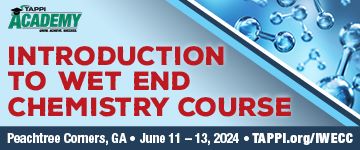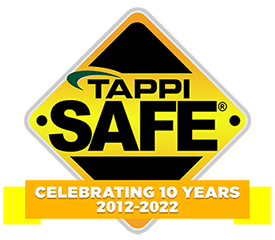 Search
Search
Use the search bar or filters below to find any TAPPI product or publication.
Filters
Content Type
Publications
Level of Knowledge
Collections
Journal articles

Magazine articles

Quantification of hardwood black liquor contamination in pine black liquor, TAPPI Journal February 2024
ABSTRACT: The presence of hardwood black liquor contamination in pine black liquor can negatively impact brownstock washer and evaporator operation, as well as reduce soap separation and yield. It is also believed to negatively impact commercial kraft lignin production. It was desired to develop a method of quantitatively determining the amount of low-level hardwood liquor contamination in pine black liquor. A method employing pyrolysis-gas chromatography mass spectrometry (py-GCMS) was developed to perform the desired measurement. Laboratory cooks with carefully controlled blends of pine and hardwood chips were prepared, and the resulting liquor was measured using this technique. Additionally, samples of pine and hardwood black liquors were blended in known quantities and analyzed. All these samples were submitted as blind samples. The resulting analysis suggests the py-GCMS method was able to accurately determine the level of hardwood contamination between 1% to 10% hardwood liquor using a low-level calibration curve prepared with coniferyl alcohol and sinapyl alcohol as standards.
Journal articles

Magazine articles

Mechanistic aspects of nanocellulose•cationic starch•colloidal silica systems for papermaking, TAPPI Journal February 2023
ABSTRACT: Optimization of a chemical additive program for a paper machine can require attention to both colloidal charges and kinetic effects. This work considered an additive program with two negatively charged substances (nanofibrillated cellulose [NFC] and colloidal silica) and two positively charged items (cationic starch and cationic acrylamide copolymer retention aid). Results were shown to depend on charge interactions; however, that clearly was not the whole story. Some findings related to cationic demand, dewatering, fine-particle retention, and flocculation among fibers were best explained in terms of at least partly irreversible complexation interactions between the charged entities. Adjustments in ratios between oppositely charged additives, their sequences of addition, and effects of hydrodynamic shear levels all affected the results. In general, the most promising results were obtained at a cationic starch level of 0.25% to 0.5% based on sheet solids in systems where the cationic starch was used as a pretreatment for NFC.
Journal articles

Magazine articles

Editorial: Reflections on the Page equation, laboratory work, and new concepts, TAPPI Journal May 2022
ABSTRACT: I began teaching paper physics to undergraduates in the late 1980s when the recognized giants in the field were still actively debating their subjects in the literature and scientific conferences.
Journal articles

Magazine articles

Flocculation of fiber suspensions studied by Rheo-OCT, TAPPI Journal September 2024
ABSTRACT: When dealing with papermaking fiber suspensions, particle flocculation takes place even before the paper web is formed. The particle flocculation depends on several aspects, including particle mass concentration (consistency), particle collisions, electrochemical interactions promoted by chemical additives, etc. Due to its importance, fiber suspension flocculation has been studied for a long time in papermaking, and several methods have been developed for this purpose. The traditional techniques include, for example, focused beam reflectance microscopy (FBRM) and high-speed video imaging (HSVI). Recently, a new optical method, optical coherence tomography (OCT), has emerged for flocculation analysis. The advantages of OCT are the possibility to study opaque suspensions, its micron-llevel resolution, and its high data acquisition speed. The OCT measurements can be combined with rheological (Rheo) measurements, allowing simultaneous measurement of both the time evolution of the floc size and the suspension viscosity. In this work, we used this approach, Rheo-OCT, to study the flocculation of suspensions of various papermaking furnishes. We analyzed the time evolution of the floc size and the fiber suspension viscosity when the studied papermaking suspensions were treated with highly refined furnish (HRF) — a furnish that contained a significant amount of micofibrillated cellulose (MFC)-type fibrils — and/or chemical additives. Such studies can lead to a better understanding of the impact of flocculation on the produced paper web in terms of qualities like formation, drainage potential, and strength behavior.
Journal articles

Magazine articles

TAPPI Journal 2016 Best Research Paper Award: Mining Big Dat
TAPPI Journal 2016 Best Research Paper Award: Mining Big Data to improve pulping and papermaking operations, TAPPI JOURNAL April 2017
Journal articles

Magazine articles

Removal of phthalate from papermaking wastewater by MIL-101(Fe) in the presence of persulfate, TAPPI JOURNAL March 2018
Removal of phthalate from papermaking wastewater by MIL-101(Fe) in the presence of persulfate, TAPPI JOURNAL March 2018
Journal articles

Magazine articles

Multiple recycling of paperboard: Paperboard characteristics and maximum number of recycling cycles— Part I: Multiple recycling of corrugated base paper, TAPPI Journal November 2019
ABSTRACT: Paper for recycling is an important fiber source for the production of corrugated base paper. The change in production capacity toward more and more packaging papers affects the composition of paper for recy-cling and influences the paper quality. This research project investigated the influence of the multiple recycling of five different corrugated base papers (kraftliner, neutral sulfite semichemical [NSSC] fluting, corrugating medium, testliner 2, and testliner 3) on suspen-sion and strength properties under laboratory conditions. The corrugated board base papers were repulped in a low consistency pulper and processed into Rapid-Köthen laboratory sheets. The sheets were then recycled up to 15 times in the same process. In each cycle, the suspension and the paper properties were recorded. In particular, the focus was on corrugated board-specific parameters, such as short-span compression test, ring crush test, corrugat-ing medium test, and burst. The study results indicate how multiple recycling under laboratory conditions affects fiber and paper properties.
Journal articles

Magazine articles

Editorial: Diverse content characterizes PaperCon 2019, TAPPI Journal November 2019
ABSTRACT: PaperCon 2019 was held from May 5-8 in Indianapolis, IN. Many of us visiting Indianapolis had little or no perception of the area beyond, of course, race cars and good sports teams. We also found a lovely, walkable downtown with a myriad of restaurants, parks, historic sites, and state government. As with the diverse offerings of PaperCon 2019’s host city of Indianapolis, the conference technical program was exceptionally broad this year. In this special issue of TAPPI Journal, we share both the breadth and quality of the content presented at PaperCon 2019 through peer-reviewed papers from the conference, as described below.
Journal articles

Magazine articles

Advantages of lean duplex stainless steels in the pulp and paper industry, TAPPI Journal April 2023
ABSTRACT: The performance of lean duplex stainless steels has been utilized by the pulp and paper industry since their introduction to the market almost 20 years ago. Experience has shown that this group of stainless steels has exceptional performance in, for example, alkaline environments towards typical deterioration mechanisms, i.e., uniform corrosion and stress corrosion cracking. The chemistry of the “lean” duplex steels is designed so that the content of volatile and expensive elements like nickel and molybdenum can be reduced to an absolute minimum without sacrificing the technical performance. This reduces the raw material cost and most importantly provides predictability of the steel price, which is often challenging with conventional austenitic and duplex stainless steels.Thanks to a dual phase microstructure and high nitrogen content, lean duplex steels have at least two times higher strength compared to standard austenitic stainless steels. This is often a preferred feature in pulp and paper construction, as it enables lighter structures and less material to be utilized. Today, lean duplex steels are widely available in various dimensions, from thin cold rolled sheets up to thick hot rolled plates. Lean duplex steels are also fully recyclable after the decommissioning stage of the equipment, thereby contributing to the circular economy.
Journal articles

Magazine articles

Water chemistry challenges in pulping and papermaking • fundamentals and practical insights: Part 2: Conductivity, charge, and hardness, TAPPI Journal June 2023
ABSTRACT: Although water is essential to the papermaking process, papermakers often overlook its importance and focus on fibers, fillers, and chemical additives. A better understanding of water properties and chemical interactions associated with water at the wet end leads to a sound foundation for high-quality paper production and smooth operation. Water is an excellent solvent for ionic substances, both organic and inorganic. These substances contribute to system conductivity, charge, and hardness and significantly impact the papermaking process. Part 1 of this paper, published in TAPPI J. 21(6): 313(2022), discussed fundamental water properties, water chemistry, and the impact of pH on pulping and papermaking operations. In this paper, we review definitions, sources, and the typical symptoms of the effect of conductivity, charge, and hardness on the productivity of the papermaking process. Sources of conductivity, charge, and hardness impacting these factors, measurement methods, and available correction strategies for their control are also discussed.






